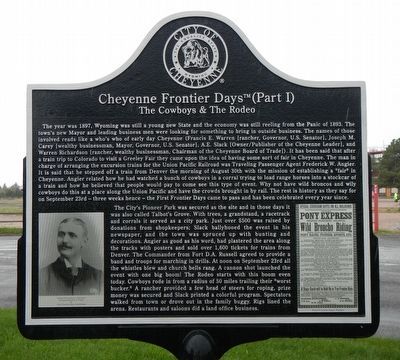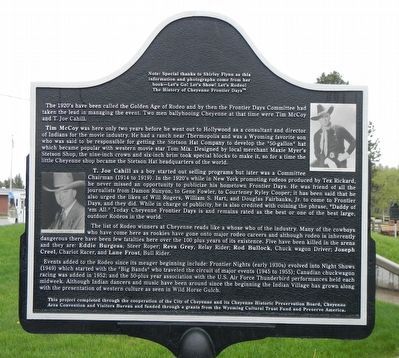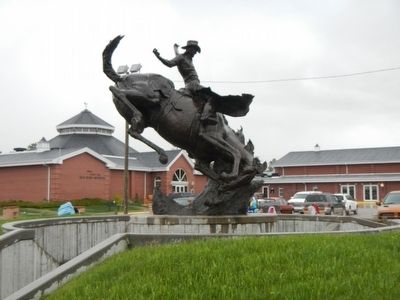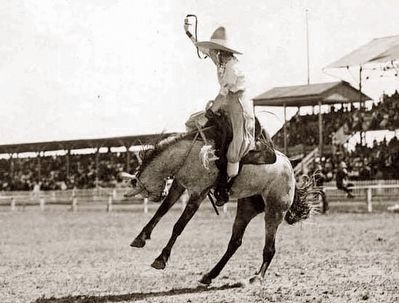Cheyenne in Laramie County, Wyoming — The American West (Mountains)
Cheyenne Frontier Days™ (Part I)
Inscription.
The year was 1897, Wyoming was still a young new State and the economy was still reeling from the Panic of 1993. The town's new Mayor and leading business men were looking for something to bring in outside business. The names of those involved reads like a who's who of early day Cheyenne (Francis E. Warren (rancher, Governor, U.S. Senator), Joseph M. Carey (wealthy businessman, Mayor, Governor, U.S. Senator), A.E. Slack (Owner/Publisher of the Cheyenne Leader), and Warren Richardson (rancher, wealthy businessman, Chairman of the Cheyenne Board of Trade). It has been said that after a train trip to Colorado to visit a Greeley Fair they came upon the ideas of having some sort of fair in Cheyenne. The man in charge of arranging the excursion trains for the Union Pacific Railroad was Traveling Passenger Agent Frederick W. Angier. It is said that he stepped off a train from Denver the morning of August 30th with the mission of establishing a "fair" in Cheyenne. Angier related how he watched a bunch of cowboys in a corral trying to load range horses into a stockcar of a train and how he believed that people would pay to come see this type of event. Why not have wild broncos and wily cowboys do this at a place along the Union Pacific and have the crowds brought in by rail. The rest is history as they say for on September 23rd - three weeks hence
- the First Frontier Days came to pass and has been celebrated every year since.
The City's Pioneer Park was secured as the site and in those days it was also called Talbot's Grove. With trees, and grandstand, a racetrack and corrals it served as a city park. Just over $500 was raised by donations from shopkeepers; Slack ballyhooed the event in his newspaper, and the town was spruced up with bunting and decorations. Angier as good as his word, had plastered the area along the tracks with posters and sold over 1,600 tickets for trains from Denver. The Commander from Fort D.A. Russell agreed to provide a band and troops for marching in drills. At noon on September 23rd all the whistles blew and church bells rang. A cannon shot launched the event with one big boom! The Rodeo starts with this boom even today. Cowboys rode in from a radius of 50 miles trailing their "worst bucker." A rancher provided a few head of steers for roping, prize money was secured and Slack printed a colorful program. Spectators walked from town or drove out in the family buggy. Rigs lined the arena. Restaurants and saloons did a land office business.
The 1920's have been called the Golden Age of Rodeo and by then the Frontier Days Committee has taken the lead in managing the event. Town men ballyhooing Cheyenne at that time were Tim McCoy and T. Joe Cahill.
Tim McCoy was here only
two years before he went out to Hollywood as a consultant and director of Indians for the movie industry. He had a ranch near Thermopolis and was a Wyoming favorite son who was said to be responsible for getting the Stetson Hat Company to develop the "50-gallon" hat which became popular with western movie star Tom Mix. Designed by local merchant Maxie Myer's Stetson Shop, the nine-inch crown and six-inch brim took a special block to make it, so for a time the little Cheyenne shop became the Stetson Hat headquarters of the world.
T. Joe Cahill as a boy started out selling programs but later was Committee Chairman (1914-1919). In the 1920's while in New York promoting rodeos produced by Tex Rickard, he never missed an opportunity to publicize his hometown Frontier Days. He was friend of all the journalists from Damon Runyon, to Gene Fowler, to Courteney Ryley Cooper; it has been said that he also urged the likes of Will Rogers, William S. Hart, and Douglas Fairbanks, Jr. to come to Frontier Days, and they did. While in charge of publicity, he is also credited with coining the phrase, "Daddy of 'em All." Today Cheyenne Frontier Days is and remains rated as the best or one of the best large, outdoor Rodeos in the world.
The list of Rodeo winners at Cheyenne reads like a whose who of the industry. Many of the cowboys who have come here as rookies have gone onto major
rodeo careers and although rodeo is inherently dangerous there have been few fatalities over the 100 plus years of its existence. Five have been killed in the arena and they are: Eddie Burgess, Steer Roper; Reva Grey, Relay Rider; Rod Bullock, Chuck wagon Driver; Joseph Creel, Chariot Racer, and Lane Frost, Bull Rider.
Events added to the Rodeo since its meager beginning include: Frontier Nights (early 1930s) evolved into Night Shows (1949) which started with the "Big Bands" who traveled the circuit of major events (1945 to 1955); Canadian chuckwagon racing was added in 1952; and the 50-plus year association with the U.S. Air Force Thunderbirds performances held each midweek. Although Indian dancers and music have been around since the beginning the Indian Village has grown along with the presentation of western culture as seen in Wild Horse Gulch.
Note: Special thanks to Shirley Flynn as this information and photographs come from her book - Let's Go! Let's Show! Let's Rodeo! The History of the Cheyenne Frontier Days.
Erected by City of Cheyenne, Cheyenne Historic Historic Preservation Board, Cheyenne Area Convention and Visitors Board, Wyoming Cultural Trust Fund and Preserve America.
Topics. This historical marker is listed in these topic lists: Entertainment • Sports. A significant historical date for this entry is September 23, 1897.
Location.
41° 9.438′ N, 104° 50.005′ W. Marker is in Cheyenne, Wyoming, in Laramie County. Marker can be reached from Carey Avenue near Lions Park Drive, on the left when traveling north. Touch for map. Marker is at or near this postal address: 4610 Carey Avenue, Cheyenne WY 82001, United States of America. Touch for directions.
Other nearby markers. At least 8 other markers are within walking distance of this marker. Cheyenne Frontier Days™ (Part II) (within shouting distance of this marker); The Trails (Part III) (within shouting distance of this marker); The Trails (Part I) (within shouting distance of this marker); The Trails (Part II) (within shouting distance of this marker); Union Pacific Steam Engine #1242 (about 300 feet away, measured in a direct line); Floyd and Edna Young Folk Art Fence (about 300 feet away); Early Cheyenne Reservoir (about 600 feet away); Fort Laramie Trail (approx. 0.3 miles away). Touch for a list and map of all markers in Cheyenne.
More about this marker. This marker is located in front of the Cheyenne Frontier Days/Old West Museum.
Also see . . .
1. The beginning of Frontier Days - Wyoming Tales and Trails. In 1897, Frederick W. Angier, Traveling Passenger Agent of the Union Pacific Railroad, suggested to the editor of the Cheyenne Daily Sun-Leader, a festival similar to Greeley, Colorado's "Potato Day." As a result of that suggestion, plans for the first "Frontier Day", were formulated in the Tivoli Saloon at the corner of 16th Street and Carey. The Saloon now houses the Chamber of Commerce. Earlier that year in May, there had been a Wild West exhibition at the fairgrounds at Pioneer Park. (Submitted on June 21, 2016, by Barry Swackhamer of Brentwood, California.)
2. Cheyenne Frontier Days is Back - Heretic, Rebel, a Thing to Flout. Known as The Daddy of ‘em All, it is both the longest continuously held cowboy competition in the world and by far the largest outdoor competition of its kind. Although there has been a National Finals Rodeo since 1956 to crown individual champions in each main professional rodeo event, that indoor competition, currently held in Las Vegas, lacks the pageantry and history that make Frontier Days unique. (Submitted on June 21, 2016, by Barry Swackhamer of Brentwood, California.)
Credits. This page was last revised on June 21, 2016. It was originally submitted on June 21, 2016, by Barry Swackhamer of Brentwood, California. This page has been viewed 549 times since then and 23 times this year. Photos: 1, 2, 3, 4. submitted on June 21, 2016, by Barry Swackhamer of Brentwood, California.



